As an Amazon Associate I earn from qualifying purchases.
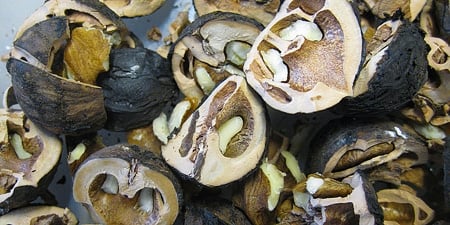
You’d think that if anything would bring out the Greed of Man in me, it would be truffles, a sexy, intoxicating food that can fetch $300 a pound or more. Yet I’ve given plenty of them away to my friends without a second thought.
No, what really makes me feel like Gollum from Lord of the Rings, the wild food I hold most precious, is my store of shelled black walnuts. Don’t even ask. You can’t have any. They are mine I tell you, all mine!
For those of you who don’t know what a black walnut is, it is a generic term for the wild walnuts native to North America. There is one main species east of the Rockies, two in California, and a couple of others in Arizona and Texas. Black walnuts are, more or less, related to hickory nuts and butternuts.
What’s the difference between black walnuts and the kind you get in the store? The vast majority of walnuts you buy in stores are English (also called Persian) walnuts, which are larger and easier to shell than black walnuts. In some places you can buy them in stores, and you can buy black walnuts online.
Size is not the main difference between black walnuts and domesticated ones. Flavor is. Black walnuts taste far stronger than regular ones: More concentrated, walnut-y, and even a touch more bitter.
To me they are the difference between cream and skim milk, grouse and chicken, a wild strawberry and one of those gigantic ones grown on the coast of California. I will take black walnuts over regular ones any time, and for any price.
Luckily that price is free: Black walnut trees grow all around us here in Northern California. My friend Josh tipped me off to a great spot, too, which has so many old trees it took my just 10 minutes to fill two 5-gallon buckets.
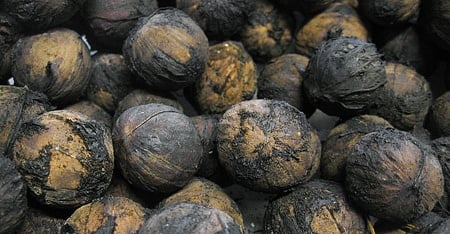
OK, maybe I lied. Black walnuts are not free — if you take time into consideration. Nothing I have ever done, not winemaking, gardening, big-game hunting, processing acorns or curing olives is as labor-intensive as harvesting, hulling and shelling black walnuts. As my fellow forager Connie Green says, “black walnuts are a fortress.” Here’s the method I figured out to storm the gates.
First you need to harvest the walnuts at the correct stage of ripeness.
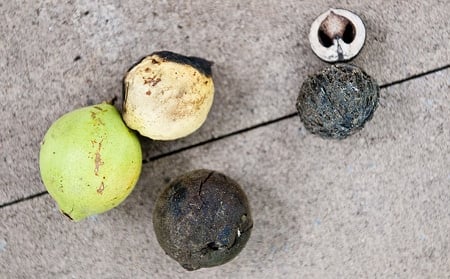
For starters, walnuts will probably not be ripe where you live until October, so wait until then to begin. November should be fine, too, and you can pick up fallen nuts from the ground around the trees into December, but by then our Little Gray Friends the squirrels will have had at them.
So you’re standing at a tree. You see all these forms of walnuts in front of you. Which to pick?
Green ones will most likely still be on the trees. Yes, you can collect them, but they have a surprise in store for you. The beige ones are rotting green ones — they are the hardest to work with, but the nut inside will still be fine. The black one at the bottom is how you will find most of your walnuts: It has its hull rotted and is pretty dry. Finally, if you’ve had lots of rain, you will find some nuts that will be pre-hulled, like the one under the half-shell.
Pick only pre-hulled walnuts that feel heavy for their size, as they will dry out in the shell once hulled.
For the most part, you will need to hull your walnuts. Lots of people say you should just drive over them with a car, but this stains your driveway. Stain? Why yes. Black walnut juice stains like nothing else. And it will not come off with any amount of scrubbing. If you fail to wear gloves when you hull black walnuts, you will have the Black Hand of Death for several days.
Sam Thayer, in his book Nature’s Garden, suggests stomping on the hulls in the field to get them off. This works, but incompletely in my experience with Northern California walnuts, Juglans hindsii. So I sit outside on my porch with three buckets — one with walnuts in it, one for the soon-to-be-hulled walnuts, and one for the hulls. I then don gloves and use a pocketknife to hull the nuts by hand.
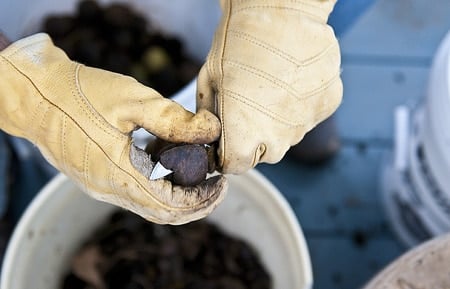
You want a relatively dull knife that you can slice with and not be in danger of it piercing your work gloves. The work can get a little slippery, especially with the green walnuts — remember the surprise? That’s it. A half-hulled green walnut is slipperier than goose shit on a doorknob. This is why I prefer the walnuts with the fully rotted black hulls.

Beware when you are hulling walnuts outdoors. Our Little Gray Friends could be lurking anywhere, just waiting to steal your walnuts for themselves. I use a biological countermeasure to keep the squirrels away:

Once hulled, your work has just begun. Now you must shell your walnuts.
This is the point at which you can kick back a bit. Hulled walnuts store well in the shell, and in fact crack better once they’ve dried for a few weeks.
Once you start shelling, however, you need to banish from your head all notions that you will be able to crack black walnuts and get those pretty perfect halves you can get with regular walnuts. Won’t happen. Bits and pieces are the price of precious black walnut meats.
I crack mine with a hammer, on the concrete floor of my garage. Such force is necessary. I’ve never heard of a regular nutcracker fierce enough to break a black walnut, although some people in the Midwest, where the Eastern species lives, have created special black walnut shellers. Anyone ever use one? I’ll buy one if they work well…
The key to the hammer technique is to use a terrycloth towel to cover the nuts, so the pieces don’t fly all over the room. Use a towel you don’t care about, as it will get holes. Smack the nut with enough force to break it, but not enough to pulverize the nut; after a few, you’ll get the hang of it.
So now you have a bucket of cracked nuts. You’re still not done! Now you need to gently remove the meats from the impossibly complex interior of the walnut. I find the best piece of equipment to do this is a stout pair of wire cutters and a nutpick. I use the wire cutters to clip the shells in key spots so larger pieces of walnut fall out. Again, after a few dozen nuts you’ll begin to know where to clip. The nutpick’s use is obvious. This is tedious work, people. I do it while watching football.
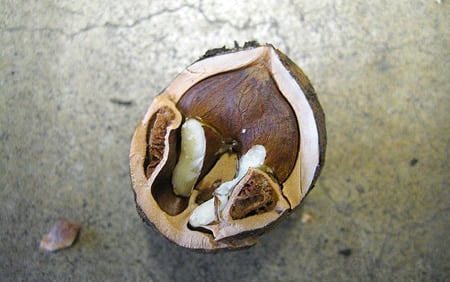
Let me tell you before you begin a black walnut adventure that you need to be patient. It took me probably six hours of work to get 15 ounces of nutmeats — although that includes hulling all of my nuts, not just the portion I cracked and picked. But all this work is worth it.
Just the aroma of black walnuts is payment for the effort: They smell toasted without actually being so. And I’ve already mentioned the flavor, which is so strong many recipes say just half the amount of black walnuts will fully replace the flavor of regular ones. I’m not so sure about that, but you can use a bit less. If you want.
Which brings me, finally, to what I do with my black walnuts. In holiday season, I make a Christmas cookie from my childhood:
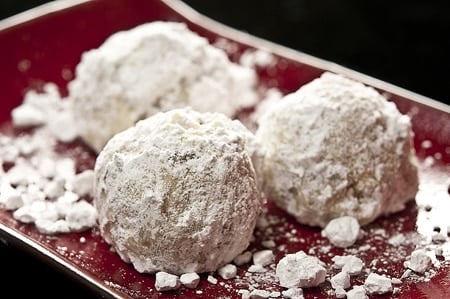
It is my version of a traditional walnut snowball cookie, also known as a Russian teacake or a Mexican wedding cake. My version has black walnuts, of course, but also orange flower water and a little orange liqueur. It’s an awesome cookie, a riff off one my mum has made for decades.
These cookies are stupid easy to make — no mixer necessary, just clean hands — and are so good you really need to make a double batch, because you will eat half of them before your friends or family come home. Trust me on this one.
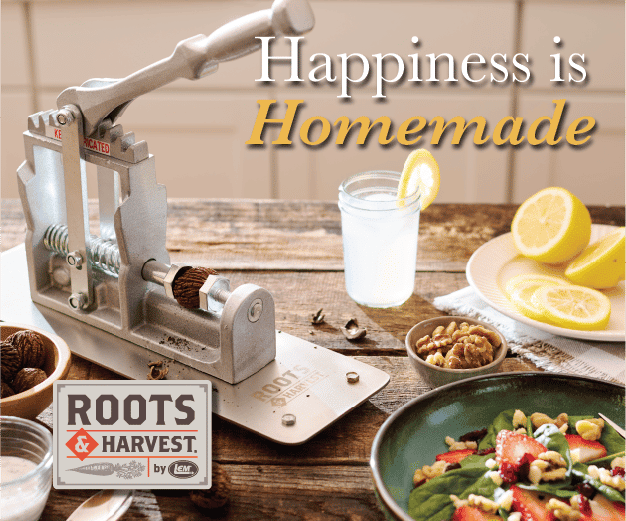

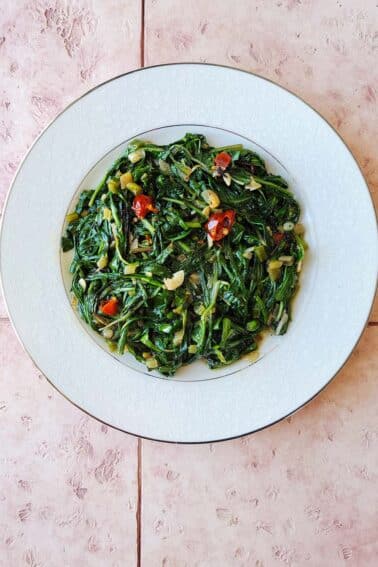
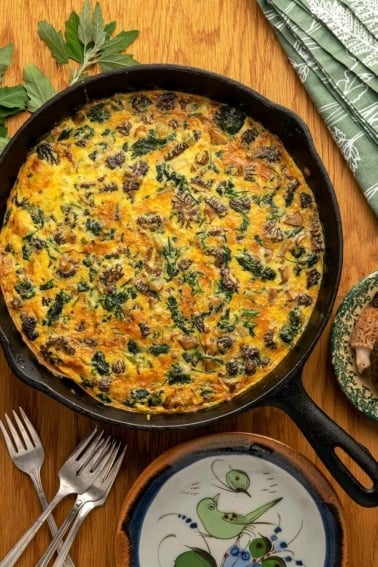
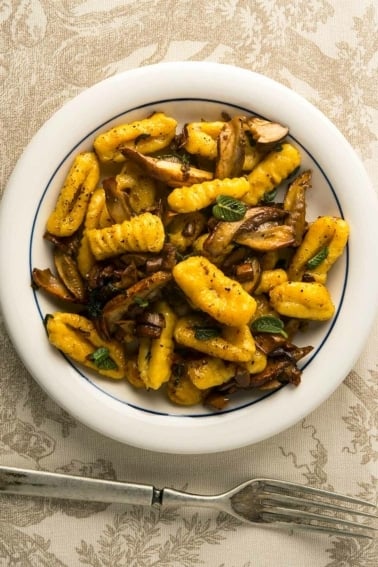
English walnuts have zero flavor to me. for years I thought they were used just to add crunch. my grandfather had on in his backyard in north Minneapolis. Mom made Swedish refrigerator cookies with them and stuffed celery every Christmas! now I am in Princeton MN with a black walnut tree. It is still small only about ten inches around but it’s been here for over 55 years, not many nuts yet. So I have to buy them now. talk about sticker shock!? still they are totally worth it!
Buy a Kenkel nut cracker and mount it vertically on a wall at a height that allows you to lean into it. Mount a shelf that will hold a rather deep container below it to catch your nuts. Cover the nut area with the cupped palm of your hand, lean forward, using your body weight rather than your arms, and when the nut cracks, let it drop into the container below. You will be amazed at how many quarters and large pieces you get. We process hundreds of pounds per year and own 3 of these wonderful nutcrackers.
You won’t be disappointed
I’m in Ontario, Canada. I knew they were a hard nut to crack, so I used my bench vice to remove the soft green cover…it usually squeezes off into two pieces in seconds. I wash as much black off the shell as possible. Then I put the nut back in the vice and, although it takes a lot of pressure, the hard shell breaks with one sharp loud cracking sound but without the mess of pieces flying everywhere.
The only downside to shelling these black walnuts was that I had black hands for days…I’m wearing gloves from now on…black ones 🙂
Get a Kenkel nutcracker. You will get a lot of quarters cracking black walnuts. Heavy duty, I have cracked hundreds of pounds.
I have 6 walnut trees in my yard. I’ve been trying to figure out what to do with all the dang walnuts! thanks for showing me how to shell them… now to find some good recipes!
My parents would pick up black walnuts from the side of the road on Sunday outings in Ohio in the 1940 ‘s when I was 10. I love black walnuts and think of how good they were and how difficult. It was for my Dad to crack but what a treat and so was your article. Oh for just one dish of ice cream full of them before my time is over. Thank you again. Where is the recipe for the cookies?
Hank, have you ever had or heard of the Italian Walnut Liqueur “Nocino”? It’s hard to find in liquor stores where I live, so I’ve been looking for a source to forage green walnuts to try my hand at making some myself. So far, no luck. It’s great in an Old Fashioned. In the mean time, I’ll have to keep stocking up on the stuff when I’m back in Wisco.
Derek, I made my own homemade Nocino a few years back. Foraging wasn’t an option in the urban jungle of South Philly, so I had them shipped from Haag Farm in California. As you probably already know, be forewarned that the green walnuts stain anything they touch. I started mine in May 2020, and adjusted the ABV somewhere around November. Still lots of tannins that needed to settle out of solution. If I were to do it again, I would think through how to get the unsavory bits to crash out. Maybe keep the nuts in a muslin bag inside the grain alcohol to ease physical extraction? Maybe look to home brew clarifying options? I filtered. A LOT. I still filter/decant the stuff I bottled a year ago. It has improved with age…
I used this recipe as a guide because it was one of the few that provided proportions: https://novocastrianvintnersgazette.wordpress.com/2018/05/18/nocino-chutney-and-pickled-walnuts/ And, yes, I also pickled the “extras” and made a chutney from the spent nuts. The pickles I liked. The chutney was only ok (a bit bitter).
Grew up in N. Indiana and black walnuts all over the place. A friend of my parents that lived in Kansas, gave mom and dad a CE Potter black walnut cracker. If you buy one, make certain it has the little sheet metal skirt that covers the nut while cracking. Otherwise, you will be picking up shell pieces (and nut meats) all over the place. I now have the nut cracker, plain zinc-grey color, no fancy rubber coating on the handle. Just the basics.
A couple years before my mother passed away, she asked if I wanted the black walnuts that were falling around the house. Sure, OK. How many do you want? Whatever there is. Don’t over do it. Again, how many do you want? Well, I picked them up around Thanksgiving that year. All 1230 pounds of them!!! After that, I was always a lot more specific in my answers.